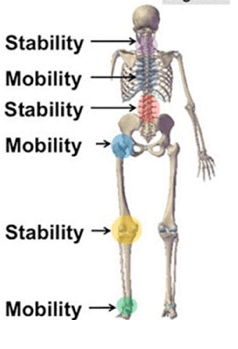You want to build some muscles, lose weight, build strength, and just be healthier overall – who doesn’t! If you only spend your time resistance training and conditioning you’re missing out on a major component of your goal. Failing to incorporate proper mobility training you fail to properly move all of your muscle around your joints!
“If you can’t get into a good position to execute a lift, you won’t be able to engage the muscles you’re trying to work, and you’re just increasing your risk for injury.” says Grayson Wickham, D.P.T., C.S.C.S.
Mobility should be seen as a prerequisite to any kind of strength training. If you can’t move your joints through a full range of motion (ROM) you will not be able to properly activate your muscles while training you won’t be able to maximize your time spent in the gym and – not to mention – increase your risk of injury. Which then leads to time out of the gym and delaying your goal.

What Is Mobility?
When you read the word “Mobility” what comes to mind? Stretching? Yoga? Lunges? Deep Squats? Truthfully, it could be any of these things – but that doesn’t really define it.
Joint Mobility is defined as the range that a joint can move before being restricted by surrounding ligaments, tendons, or muscles. Aka the range of uninhibited movement around a joint.
It’s important to understand that mobility and flexibility are not the same thing, but it is close. Mobility incorporates flexibility and strength in order to help you better activate your muscles, squat deeper, push harder, and jump higher.
Think about it, there are SO many moving squats in a simple squat from your ankles to your knees to your hips not to mention your shoulder girdle if you include a barbell. Making sure that all of these moving parts can properly execute the movement desired WITHOUT load will allow you to train effectively AND pain free.

Why You Need To Start Doing Mobility (Or Start Doing It Better)
You might’ve heard this before but it’s worth repeating: we live in a day and age where we spend so much time in poor static positions between sitting at a desk all day, watching TV, looking at your phone, or driving which leads to getting our body ‘tight’ and has us lacking optimal range-of-motion and activation of specific muscle groups.
The human body was designed to not just move but move often and freely! If you don’t take the time to move your joints it’s only a matter of time before injury and pain set in.
Having limitations in your joint mobility will lead to other joints and muscle needing to work twice as hard to get you moving the way you ask of it.
This is actually one of the main reasons why low back pain is so prevalent in western culture. If your hips aren’t mobile, your low back will have to take over as your “hips” and compensate for the immobility of your hips. This is known as compensatory strength.
Compensatory strength isn’t always bad but it can only last for so long though before your body stops responding to load or certain body positions and injury/pain begin to set in.

Here’s an example of someone with poor ankle and hip mobility (right) performing a squat. As you can see, they can’t sit their hips down as low as the image on the left because of their mobility restrictions. So to lower the barbell to the desired depth they begin to compensate for their lack of mobility by leaning forward which then adds excess strain to the lower back.
A day later that lower back compensation might start off as some extra soreness in your lumbar spine; but continuing to lift in this matter will ultimately lead to your back giving up on you whether that’s while you’re lifting or even bending down to pick up your kids.
How To Improve Your Mobility
Don’t think of mobility as a specific type of workout, but rather as a general athletic skill, like strength or power.
Just like strength and power, you will need to build mobility with multiple techniques in order to improve it.
I prescribe all of my clients perform 5-15 minutes of mobility work prior to beginning each training session. Even though the specific exercises I prescribe will always differ from person to person depending on their needs, certain principles will always apply.
Move slowly and deliberately. Controlled dynamic stretching or Controlled Articular Rotations (CARs) are only truly beneficial when you are mindful of the movement and how your joint feels throughout the entire exercise.
Mobilize For Movement. Perform mobility exercises that will directly apply to your training session. If you are about to train lower body, get your hips and ankles moving properly before adding any weight.
Here are a couple movements that can help get you started improving your mobility journey.
Ankle
Hip
Thoracic Spine
Shoulder Girdle
Follow Me On Instagram Here For More Informational Posts Like This One!







